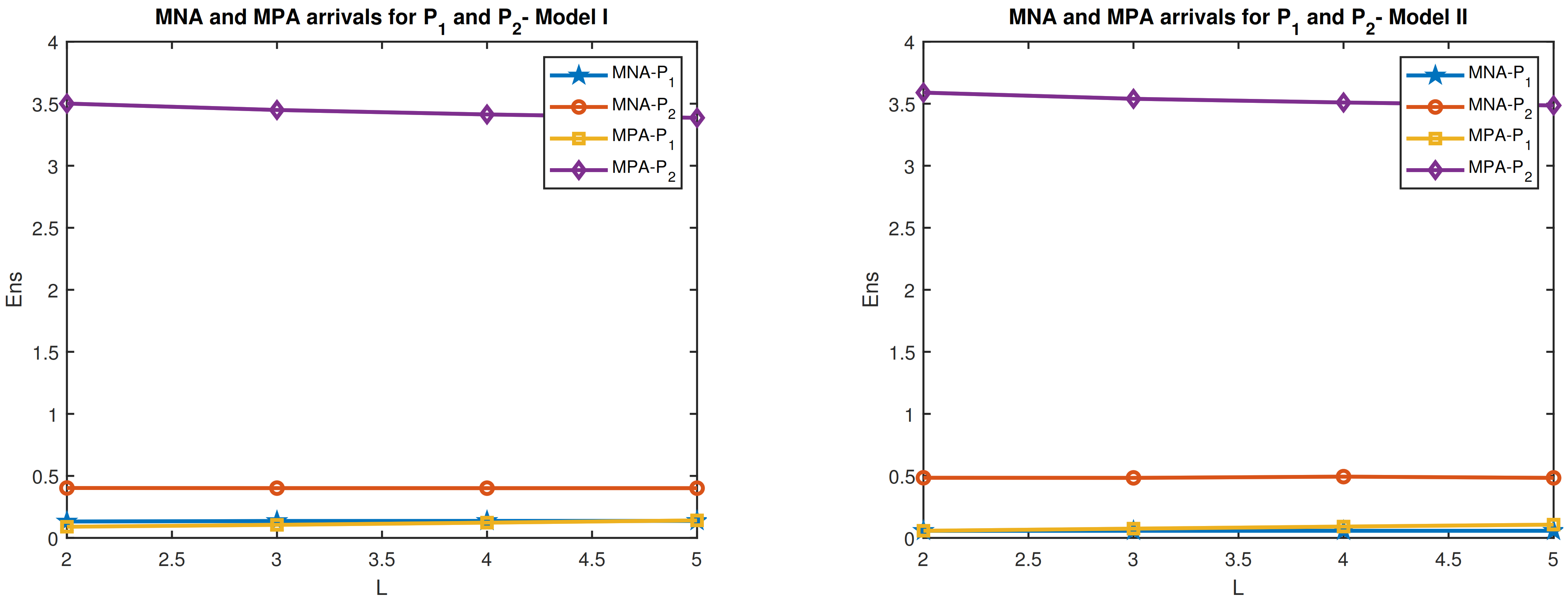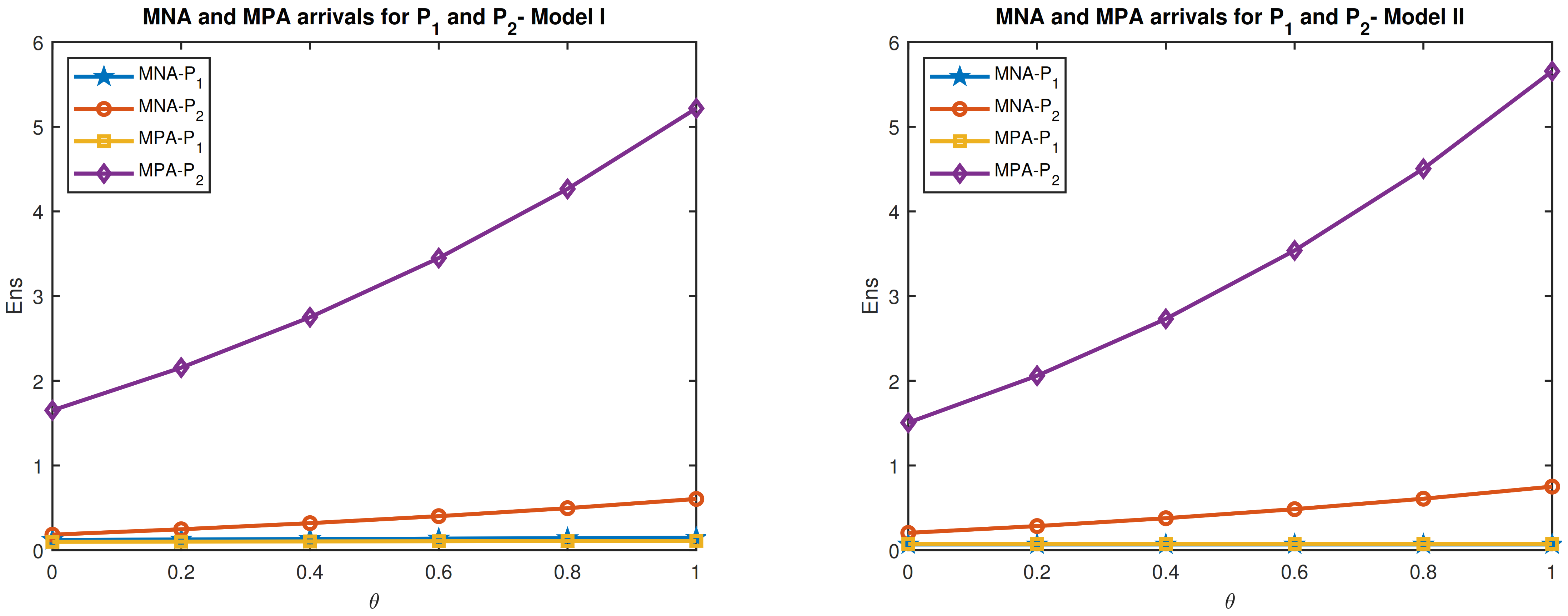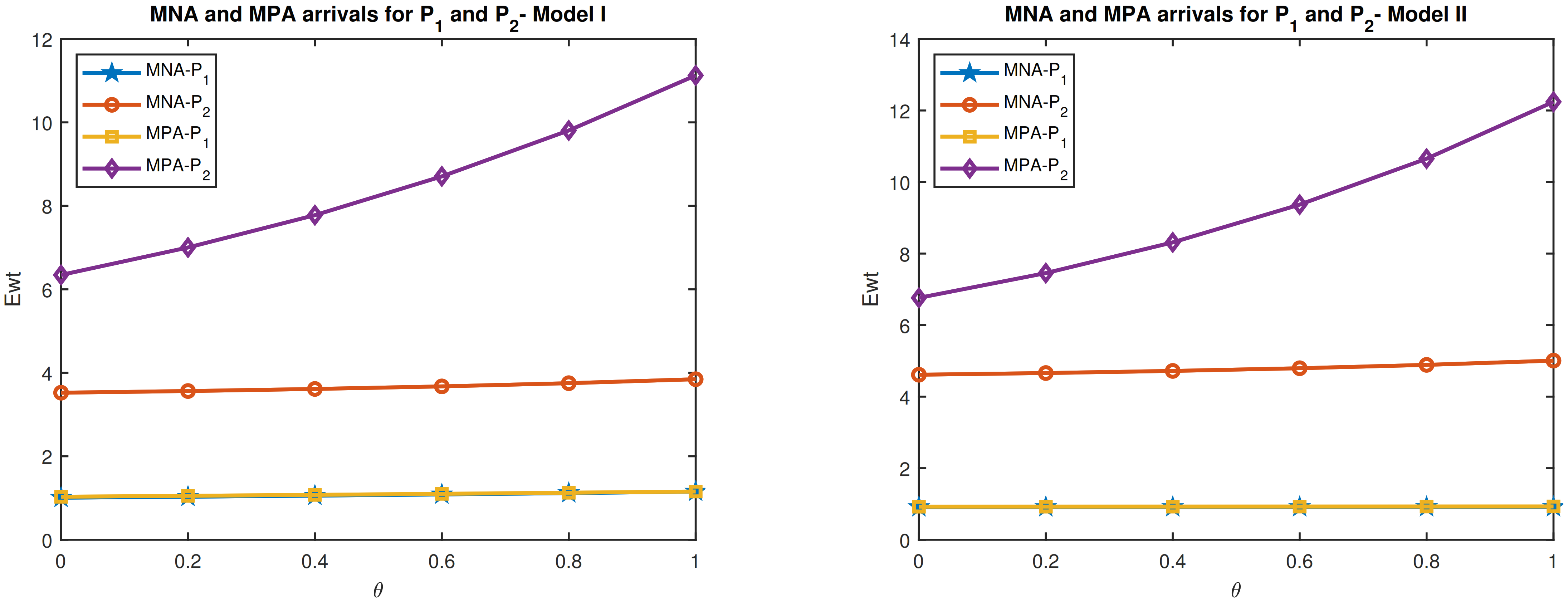In this paper, we discuss two queueing models arising due to feedback of customers from a high priority queue ( queue) joining a lower priority queue ( queue), in a single server queueing system. The queue is of finite capacity whereas the queue has unlimited capacity. Immediately after service completion high-priority customers tend to provide feedback on the service again. The probability for feedback at a service completion epoch is which is independent of the feedback by other customers and also the number of customers in the system. However, they are to join a low-priority queue. In addition to this stream of customers in the queue, customers belonging to such class from outside also join that queue. The two models considered are the preemptive and non-preemptive services of customers. The flow of customers constitutes a Marked Markovian arrival process. and customers have service times following two distinct and mutually independent phase type distributions.
Because some abbreviations appear, mostly in this section, we introduce them at this stage for easy reading.
In addition to introducing some new notions in feedback and priority queues, this paper extends earlier work to a much more general framework. The salient features of the present paper are:
Before going to further details of the paper, we provide literature review on the two topics—feedback and priority queue.
1.1. Literature Review of Feedback Queues
FBQ are extensively discussed in the queueing literature. They are adequate mathematical models of computer communication networks, manufacturing systems, inventory management processes, and many other systems in which a few served customers may require re-servicing for some reason. Indeed, in information transmission systems, erroneously transmitted data (packets, frames, etc.) are re-transmitted; defective items produced during a manufacturing process have to be re-processed, and so on.
Although these systems are widely used in real life, they have not been sufficiently studied for a long time. Such models were first introduced in [
2,
3]. After these pioneering works, researchers again did not pay attention to them for a long time. Only in the last three decades have such systems been intensively studied by various authors.
In the class of FBQ, it is necessary to distinguish two subclasses: IFBQ, where a return occurs immediately after the service is completed, and DFBQ, in which a request by a customer who was already served out occurs after the elapse of a certain amount of time.
In [
4,
5], detailed reviews of work conducted on FBQ until 2015 are provided. Therefore, we restrict ourselves to those published from 2016 onwards.
Note that in most of the work reported on FBQ, no separate queue for such customers is considered. In such kinds of systems, it is very hard to control the loss probabilities of primary and feedback calls. To reduce the loss probabilities of calls, sometimes an orbit(s) for both kind of calls is organized. In recent years, models of feedback queues with reliable and unreliable server subject to various schemes of breakdowns and repairs, have been investigated (see Rajadura et al. [
6], Ke et al. [
7], Singh et al. [
8], Jailaxmi et al. [
9], Chang et al. [
10], Chang et al. [
11], Madheswari et al. [
12], Melikov et al. [
13], Jain and Kaur [
14]). The above-mentioned authors study the IFBQ model with buffers as indicated in the respective papers.
In VijayaLaxmi et al.’s work [
15], the model of a feedback M/M/1 queueing system with correlated reneging and WV is examined. To compute the long run system state distribution of the resulting three-dimensional Markov chain, a matrix-geometric method is employed. Using this, several system performance measures are calculated and an optimization problem discussed.
Bouchentouf et al. [
16] consider an M/M/1/N feedback queue with server vacation, balking, reneging and holding those reneged customers to the system.
To study a single channel cognitive radio network with a slotted time structure, Zhao and Yue [
17] perform analysis and optimization of the system with a finite primary buffer and a probabilistic returning scheme. PU packets can always be transmitted on the channel because the channel is authorized to do so. However, SU packets that access the system, are transmitted opportunistically. To reduce packet loss probability, separate finite buffers are organized for both kinds of users. It is assumed that PU packets have preemptive priority over SU packets, i.e., a PU packet can interrupt an SU packet’s transmission. A feedback scheme is accepted for interrupted SU packets, i.e., it is assumed that an interrupted SU packet, in accordance with the Bernoulli scheme, can either be admitted through the SU buffer and wait for the next transmission or be forced to leave the system.
Melikov et al. [
13] analyze an IFBQ with heterogeneous servers and MMPP flow. Primary calls are served on a high-speed server. On completion of service, each call either leaves the system or asks for repeated service according to a Bernoulli scheme. Such calls, on completion of service by a slow server, leave the system or return for re-servicing according to the Bernoulli scheme. With the arrival of a primary call, if the queue length of such calls exceeds a certain threshold value and the slow server is free, then the incoming primary call is either directed to the slow server or joins its queue according to the prescribed Bernoulli scheme. Algorithms for calculating the steady-state system probabilities approximately are proposed for both finite and infinite capacity systems. Their high accuracy is demonstrated.
Melikov et al. [
18] discuss methods to calculate the system state distribution with instantaneous feedback and a varying arrival rates in a Markov model of a servicing system with one server. At a service completion epoch, the customer either leaves the system or immediately returns to receive the service, which is repeated according to a predefined Bernoulli scheme. Prior to a repeated service, a random server switching time is needed. The rate of arrival of external customers depends on whether the server is in operating or switching mode. The condition for ergodicity of this two-dimensional Markov chain is obtained. Further, three methods for studying it are implemented: the method of generating functions, the method of spectral expansion, and the space merging method.
Melikov et al. [
19], analyze a multi-channel queuing system with MMPP flow and delayed feedback. After receiving complete service, customers will decide either to feedback with some state-dependent probability or to leave the system forever with complementary probability. Feedback calls organize an orbit of repeated calls. If all channels of the system are busy when a repeated call arrives, then it either leaves the system with some state-dependent probability or with a complementary probability returns to orbit. Methods to calculate the steady-state probabilities of the appropriate three-dimensional Markov chain, as well as some performance measures of the system under consideration are developed.
1.2. Literature Review of Priority Queues
Priority queues were first considered by White and Christie [
20] as a queue with interruption of service of low priority customers to provide service to higher priority customers. A priority queue with preemptive service can be regarded as a queue with service interruption. For example, a doctor renders their service to a causality patient urgently by interrupting the present consultation in case it is not critical. Jaiswal [
21] is in the preemptive priority queue with resumption of service of the low priority customer and Jaiswal [
22] discusses time-dependent solutions in priority queues. Cobham [
23] considers a non-preemptive priority queue and derived the expected waiting time in equilibrium. A detailed discussion of development in priority queues until 1968 is given in Jaiswal [
24]. More recent developments on priority queues could be found in Takagi [
25] and Brodal’s work [
26].
Interruption in service due to server failure is discussed extensively in the literature. In the survey paper by Krishnamoorthy et al. [
27], an account of various types of server interruptions is provided. This includes interrupting current service to attend higher priority work.
Customer induced service interruption, as coined by Jacob et al. [
28], is in contrast to that of interruption due to server failure. This is carried out for the single server case, where customers who experienced interrupted service are given priority over primary customers. Here self-interrupted customer takes an exponentially distributed time to get out of interruption. This is extended to the multi-server case in Krishnamoorthy and Jacob [
29]. All underlying distributions (inter-arrival time, service time, inter-interruption time, interruption fixation time) are assumed to be independent exponential random variables. Dudin et al. [
30] extend the above case to a Markovian arrival process and phase type service with c servers and negative customers with a few protected service phases.
Lowering of priority of customers in feedback queues is introduced in Krishnamoorthy and Manjunath [
1] (see also the Doctoral thesis by Manjunath [
31], Chapter 3). Following these works, we assumed that the
customers who opt for feedback are allotted low priority and so joins the
queue along with those customers who are primary
customers.
We can increase the amount of feedback permitted to both classes of customers up to a finite number. This could be achieved by introducing feedback of customers after service, placing them in a queue labeled , in which customers of priority 3 join from outside. This can be repeated up to a maximum of K feedback by customers, feedback by customers, and just 1 feedback by customers. If all queues are allowed to have infinite capacity, then the block matrix entries themselves will be of infinite dimensions. In the simple case of Poisson arrivals of external customers to the respective designated queues and exponentially distributed service time, we will be able to derive explicit expressions for system state probability.
Note that the low priority queue(s) is generated by an internal mechanism as well as an external one in the present paper. However, Krishnamoorthy and Manjunath [
1] consider only the internal generation of feedback customers. They were able to employ the matrix geometric method, with all queues having infinite capacity because all underlying distributions were exponential. This helped them achieve a very nice structure for the infinitesimal generator of the resulting continuous-time Markov chain. The block matrix entries in the infinitesimal generator are also of infinite dimensions.
Note that the low priority queue(s) are dependent on the higher priority ones also in its evolution. For example,
depends on
and
when we consider at least three distinct priorities. Various feedback policies in different queuing models are studied in the literature (see, for example, [
2,
32,
33,
34,
35,
36,
37]). An M/G/1 retrial queue with instantaneous customer feedback is considered by Krishnakumar et al. [
38]. In this, the feedback customer joins the tail end of the queue. In [
39], Krishnakumar et al. analyze a queue with more than one server; here, it is also assumed that the feedback customer joins the tail end of the queue. A queue with collisions and instantaneous feedback of unsatisfied customers is the theme of discussion in Krishnakumar’s work [
40].
Prior to the introduction of a queue generated by feedback customers, the feedback considered fell into two categories: Either the feedback customer joins the tail end of the queue on completion of service so the service is repeated or he occupies the server immediately on completion of the service without joining the queue.In these two cases no separate queue for feedback customers is provided. Further, they have the disadvantage of non-identification of feedback customers. Additionally, note that there may be several feedback customers in the system at a time, some of whom have repeated this several times. In the second case, there is at most one feedback customer at any time in the system. If at all there is one, it is the one undergoing service. In the models that we discuss or in their extension to K feedback, we cannot distinguish feedback customers and primary customers in lower priority queues. However, if we do not allow the external flow of customers to queues, except the feedback customers from the immediate higher priorities, then all customers in the remaining queues are feedback customers. This helps in the control of the number of feedback to be allowed in a service system.
The following explanation gives the motivation behind this paper.
The type of feedback which is introduced here is totally different from those discussed in the literature prior to 2018. The feedback customers considered in this paper are given a lower priority. This is because during a service, for example, purchase of equipment, customers are given detailed explanation about the functioning of the system. After this exercise, a few customers may have the tendency to keep on asking questions about the machinery. This is a big nuisance to big organizations who want this process to be brisk. Thus, those customers who are not satisfied by the first service are directed, immediately after service completion, to the lower priority queue. External customers also join this lower priority queue. Thus, here we notice an interplay between feedback and priority. This also could be seen in offices as follows: suppose a customer requests for a service-this may involve search of previous records. So, after providing him/her with the basic service, the system directs the customer to wait in a separate line, which will be attended when the server becomes free from the first queue.
From the application point of view, we can introduce certain control policies: What is the optimal number of feedback which should be allowed to each priority class when there are at least two priority types considered? This involves the computation of the optimal number of waiting lines that should be provided in the system.
The remaining part of the paper is arranged as follows. Description of model I and its mathematical formulation are given in
Section 2.
Section 3 provides the ergodicity condition and an algorithm to calculate the steady-state probabilities of the LIQBD associated with the problem. Derivation of waiting time of
customers and that of customers in the
queue are discussed in
Section 4. Additional performance measures are given in
Section 5. Model II is described in
Section 6 and further its mathematical formulation is also given in that section. A steady-state analysis of that model can be found in
Section 7. The analysis of
customers’ waiting time and that of customers in the
queue appear in
Section 8. Additional performance measures are recorded in
Section 9. Results of numerical experiments are demonstrated in
Section 10.
Following notations are used in what follows:
: Column vector with all entries 1 of order to be specified.
: Transpose of .
: Continuous time Markov chain.
I: Identity matrix of appropriate order.
: Identity matrix of order a.
: Matrix of order having 1 at position a and 0s’ elsewhere.
QBD: Quasi-Birth-and-Death
: entries of
: entry of
: entry of










